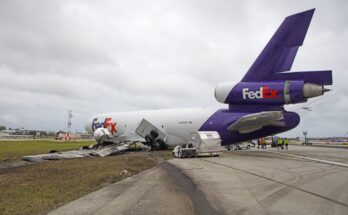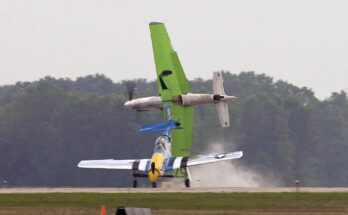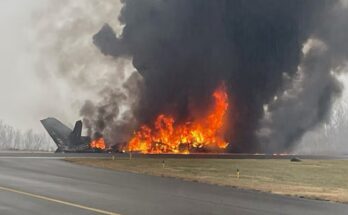
Another Balloon Accident! 😱
Thursday, June 26, 2025 – Late Afternoon
A peaceful afternoon in Slovakia’s Ilava District was shattered when a tragic hot air balloon accident unfolded near the village of Boselov in the scenic Považie region. At around 4:30 PM local time, a hot air balloon identified as a BB37N model, registration number OM-8002, erupted into flames mid-air before crashing into an open field. The balloon, operated by Lety Balonom, s.r.o., a Slovak company specializing in scenic balloon tours, was completely destroyed in the blaze.
Eyewitnesses described the horrifying scene as flames began to engulf the balloon’s basket while it was still airborne, approximately 200–300 meters above ground. Screams could be heard from the gondola as the pilot and passengers struggled to deal with the rapidly worsening situation. Within minutes, the balloon descended rapidly, trailing smoke and fire before impacting the ground with a loud explosion.
Initial reports indicate that the flight carried a total of six people – one pilot and five passengers. Emergency responders arrived at the scene within 15 minutes, but the fire had already consumed most of the structure. Tragically, four individuals were declared dead on the scene, while two others were transported to the Ilava Regional Hospital in critical condition, suffering from severe burns and traumatic injuries.
The Slovak Transport Authority and Aviation Accident Investigation Board have launched a full-scale investigation into the incident. While it’s too early to determine the exact cause, early speculation suggests that a gas leak may have occurred in the burner system, causing a rapid and uncontrollable fire. Investigators recovered the wreckage, which was still smoldering when they arrived, and have begun analyzing debris to identify any mechanical or human errors that may have contributed.
Lety Balonom, s.r.o. released a brief statement late Thursday evening expressing their sorrow:
“We are devastated by the tragic accident involving one of our aircraft today. Our hearts go out to the families of those affected. We are fully cooperating with authorities in their ongoing investigation and have grounded our fleet until further notice.”
The BB37N is a relatively common model used for commercial and recreational ballooning. Known for its wide passenger capacity and dependable performance, it has a solid safety record globally. However, like all hot air balloons, it relies heavily on a combination of propane-fueled burners, durable envelope fabric, and expert piloting – a delicate balance that can turn deadly when disrupted.
Local residents told reporters that they had seen the balloon flying unusually low just minutes before the crash. One witness, Martin Kovac, a local farmer who was working in his field, said, “I saw the balloon coming down fast. At first, I thought it was just landing, but then I noticed black smoke and fire from the basket. It was terrifying. I called emergency services right away.”
The Považie region is known for its beautiful landscapes and gentle air currents, making it a popular area for hot air balloon rides, especially during the summer months. This accident has sent shockwaves through the local tourism industry, and many have begun questioning whether enough safety oversight exists for balloon operators in Slovakia.
This is not the first time Slovakia has experienced a ballooning accident. In 2015, a hot air balloon caught fire during landing near Nitra, resulting in two fatalities. That incident prompted new safety recommendations, including more rigorous maintenance checks and additional pilot training. However, those regulations are not always strictly enforced, especially by smaller operators.
Aviation safety experts emphasize that while hot air balloon accidents are rare compared to other forms of aviation, they often result in high fatality rates due to the open nature of the craft and limited emergency options. When fire breaks out aboard a balloon, passengers typically have no way to escape.

Professor Jozef Hlinka, an aeronautical safety specialist at the Slovak Technical University in Bratislava, stated:
“The tragedy near Boselov underscores the importance of strict adherence to safety procedures in ballooning operations. A fire at altitude is among the most dangerous scenarios imaginable. This incident must prompt a national review of ballooning standards.”
Families of the victims have already begun gathering near the Ilava hospital and the crash site. Grief counselors and local officials have been deployed to provide support. Slovak Prime Minister Zuzana Šišková released a statement of condolence:
“This is a dark day for Slovakia. Our thoughts are with the families of those who lost their lives, and we pray for the recovery of the injured. We are committed to ensuring that a thorough investigation brings answers and justice.”
Meanwhile, aviation enthusiasts and the general public have taken to social media, expressing sorrow, outrage, and calls for stricter regulations. “How many more lives have to be lost before we treat ballooning with the same level of scrutiny as other aviation sectors?” one post read, receiving thousands of shares and comments.
As the investigation proceeds, all hot air balloon flights in the region have been suspended temporarily. Lety Balonom’s operating certificate is under review, and other ballooning companies across Slovakia are being urged to reexamine their safety protocols.
For now, the rolling hills of the Považie region bear the marks of tragedy. A scorched patch of earth stands as a grim reminder of how quickly a scenic adventure can become a nightmare.
This latest accident has reignited debates across Europe about the regulation of recreational aviation experiences. With summer tourism ramping up, many are asking whether existing oversight is sufficient to protect passengers seeking breathtaking views from the sky.
As investigators sift through the ashes of OM-8002, the country – and the world – watches closely, hoping that answers will come swiftly and that those responsible, if any, will be held accountable. Most importantly, that measures will be taken to ensure that such a tragedy never happens again.


